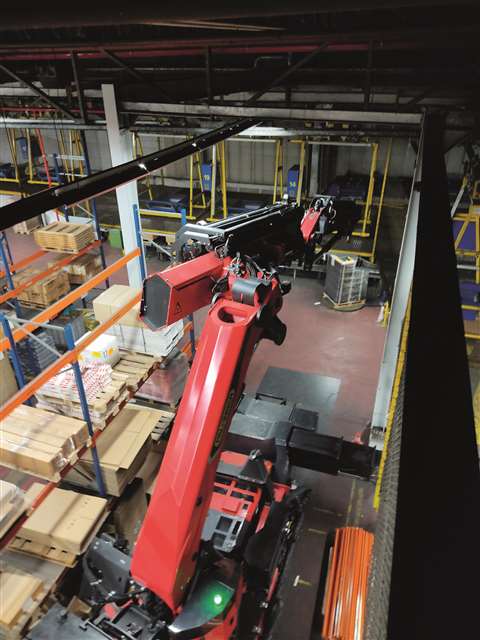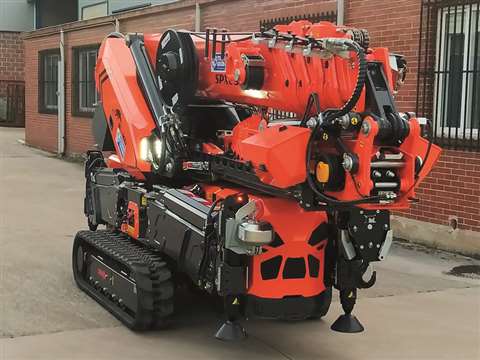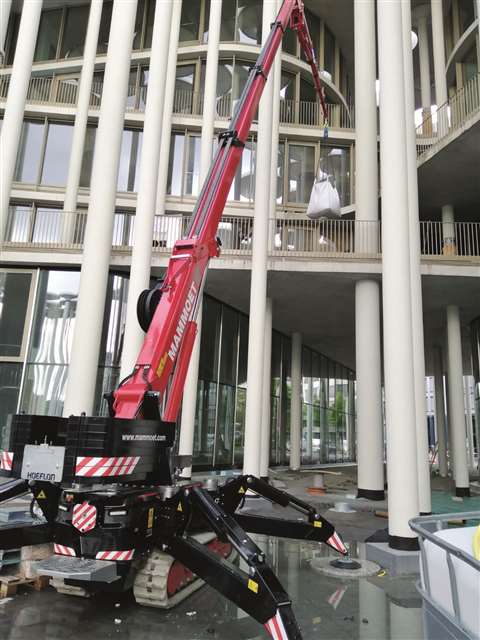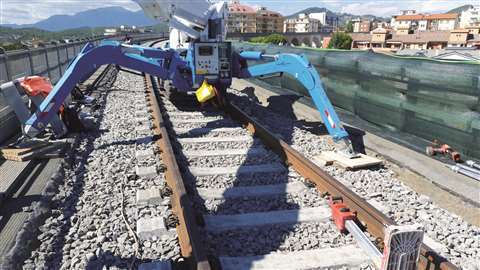What are the big advantages of mini crawler cranes?
06 May 2022
Some of the smallest cranes available, mini crawler mounted articulating cranes, offer big advantages for confined workspaces. Niamh Marriott reports
Despite their diminutive size, mini crawler mounted articulating cranes can be indispensable on a wide range of job sites.
 Palfinger’s PCC115.002 can split to shift inside a building (Photo: Palfinger)
Palfinger’s PCC115.002 can split to shift inside a building (Photo: Palfinger)
Austrian crane manufacturer Palfinger’s Hemmo Luijerink says “smaller cranes offer tremendous help with small onsite assembling and installation jobs,” and that they each certainly have their place among the larger range of crawler cranes.
“Of course the genes of the PCC help here, being able to demount the crane from the crawler, make it literally walking on its outriggers, forward and sidewards like a crab. This is extremely useful inside petrochemical plants, industrial installations for 24-hour maintenance and upgrading, as well as in city centres and tunnels.
“Compared to conventional stiffboom cranes, the PCC is extremely low. With the crane separated from its crawlers and sitting on the ground, the boom can horizontally go inside everywhere.
“Even through the smallest doors, the crane stands outside but the lifting happens inside, with a knuckle boom on a hook, or with a 3.5 tonne winch giving more than 12,000 kg capacity on four falls of rope.”
Getting to site and fitting through difficult access routes is an advantage offered by mini crawler cranes. They are designed to provide the most capacity for their small size, weight and footprint.
Small crawler cranes
Treviso, Italy-headquartered mini crane manufacturer Jekko offers articulated boom crawler cranes: JF365, JF40, JF545, JF545 V-Max and JF990, plus straight boom models. They are designed to fit through a standard single doorway or in an elevator, for work in confined areas.
The JF545 combines the performance of a truck-mounted crane with the benefit of a self-propelled crawler chassis, Jekko says. It was designed as a starting point for a new future for crawler cranes. Customers define it as a versatile crane, easy to use, with great load power and compact (5.4 x 1.8 x 2.8 metres), the company says. Its articulated main boom has six extensions.
Jekko says the advantage of the V-Max version is a jib and a mounting for hydraulic tools such as auger, grapple or bucket. The Jekko JF365 has a fixed base with a load capacity of 2.7 tonnes. It offers the same options as the JF545: proportional radio control, hydraulic activation for accessories, stability control and a smaller and lighter jib which allows installation of a platform.
The JF40 is the smallest Jekko at 2.4 x 0.8 x 1.8 metres, while the JF990 is the largest, with dimensions of 6.7 x 2.1 x 3.4 metres.
Jekko has identified an industry need for small crawler cranes that also have a small carbon footprint. The company launched its mini crawler crane SPX650 in 2020. This year, Spanish boiler manufacturer Talleres Laguillo purchased the first diesel and electrically powered version of that model.
The Cantabria, Spain-based company chose the 5 tonne capacity model for its indoor and outdoor capabilities; it can reach a maximum height of 23.5 metres with a jib.
Dual powered compact crawler
Ian Trenzano, sales manager at Jekko Spanish distributor Transgrúas, says, “The SPX650CDH is very compact and it’s a high performance model. We’ve already sold four and three additional ones will soon follow. We think we can sell many more to plant hire companies, who’ve shown their interest.”
 Spanish boiler manufacturer Talleres Laguillo purchased the first diesel/electric powered version of Jekko’s spider crane (Photo: Jekko)
Spanish boiler manufacturer Talleres Laguillo purchased the first diesel/electric powered version of Jekko’s spider crane (Photo: Jekko)
“Jekko is extremely satisfied on having delivered the first diesel-powered SPX650 to Spain. Countries such as Spain and Italy are going through the ecological transition in a similar way: both responsive to this topic yet aware that diesel systems still play a major role,” adds Jekko’s head of sales Alberto Franceschini. “We have combined this latter with an electric motor to turn the SPX650CDH into a real eco-friendly crane for the Spanish and Italian yards.”
For a video of this crane click here.
Cranes for confined areas
Mini crawlers come to the rescue for projects where other cranes can’t even fit through the door. The larger manufacturers note their usefulness and even the biggest see the value in investing in the smallest models.
Back in 2018 international heavy lift and transport specialist Mammoet expanded the small end of its fleet with a pair of new 4 tonne capacity Hoeflon C10 mini crawlers.
The Dutch-built telescopic C10 is 800 mm wide to fit through doorways. Target applications include work in refineries and industrial plants where there is no room to get a conventional crane.
At the maximum 19 metre reach it can lift 209 kg and the greatest hoisting height with all extensions is 22 metres. It weighs 4.7 tonnes and can be fitted with a radio remote control. Power is from a three cylinder Yanmar diesel but it can also be powered electrically. The track width can be adjusted for optimum stability according to the available space.
 Mammoet’s 4 tonne capacity Hoeflon C10 mini crawler crane (Photo: Mammoet)
Mammoet’s 4 tonne capacity Hoeflon C10 mini crawler crane (Photo: Mammoet)
Mammoet intends for the range to run alongside its existing trailer and loader crane fleet for industrial services customers. Gert Jan Uildriks, Mammoet Assen branch operations manager, says while Mammoet is known for its big projects, it has significant operations in it rental business and maintenance work.
“The addition of the Hoeflon C10 means we now have the necessary and complete range of equipment to expand into new and growing markets, such as machine relocations,” Uildriks says.
Continuous control for crane operators
GGR Group’s range of mini crawlers includes its TMC 525 with a capacity of 14 tonnes and a maximum lift height of 32 metres. It benefits from continuous slewing which gives good control for load placement and it can travel on rough or uneven terrain, and slopes. Data can be fed back to the operator via the remote control transmitter during lifting operations.
There is also an electric version. The lithium-ion battery-powered TMC25 retains all the compact dimensions and lifting power of the diesel variant, GGR says. At 780 mm wide it is designed to reach the tightest of areas. Further reach is afforded by its dynamic jib that can extend maximum working radius from 8.43 to 12.85 metres
Zero carbon cranes
Going green is increasingly securing contracts for jobs, says Luijerink at Palfinger. “This green thing is becoming a part of the tender, for getting a job. Mainstream heavy lift companies are recognising the benefits of e-drive. Zero carbon footprint on site, low[1]noise and with an energy consumption which in general is very low, just 15 kW. Compare that with a 300 kW roaring diesel drinking away your precious fuel hour after hour.”
 The Ragno XTJ 37 by Palazzani (Photo: Palazzani)
The Ragno XTJ 37 by Palazzani (Photo: Palazzani)
Italy-based Palazzani has provided two units to help with the electrification of a railway line between the towns of Pettoranello and Isernia in the south-central Italian region of Molise.
The Ragno XTJ 37 was used for negative work on a railway bridge, while a Ragno XTJ 43 was commissioned for works around tunnel arches.
As Palazzani explains, workers had to carry out inspections on the railway bridge in question and subsequently core drilling and installation of plates to support poles on the external side of the bridge.
On some areas of the bridge it was possible to operate from the road below using the XTJ43, but at some points the work could only be carried out with access from above. The XTJ37 made it possible to carry out the work safely and efficiently, the company says.
Space restrictions on site meant there was less than four metres width at some points, posing a challenging scenario for the operators to secure the unit for the work. An onboard generator was necessary for the operation of tools in the basket.
STAY CONNECTED


Receive the information you need when you need it through our world-leading magazines, newsletters and daily briefings.




